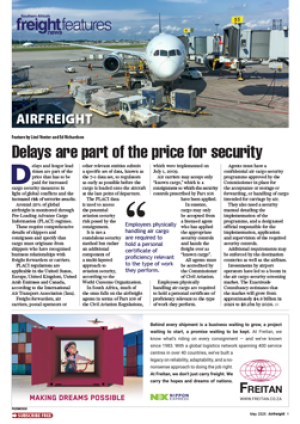PREVENTION IS better than cure when it comes to managing cargo risk. In this special feature inspection agents, packaging specialists and
insurance experts offer their advice
on limiting risk, while service
providers like Portnet and Spoornet outline the steps they have taken to protect your cargo.
CT port is set for
ISO-making history
Special security measures over and above
ISO 9002
have been put into place
PORTNET IS eagerly awaiting two watershed dates that should help recognise the Port of Cape Town as the most progressive and secure of the seven ports in Southern Africa under the South African harbour authority's management.
April 1, 1999 will be no joke for thieves targeting the busy port situated right next to South Africa's most popular tourist attraction, the V&A Waterfront.
With 20 000 vehicles passing through the harbour's five entry and exit points daily, including commuters taking short cuts and Waterfront visitors, Portnet operations manager Malcolm Green told FTW that years of training, improving security measures, increased funding and studying foreign ports starts paying off on April Fools Day when the Port of Cape Town finally receives its long sought ISO 9002 accreditation.
The Port of Cape Town is the first in Portnet, the first in South Africa and as far as I know the first in Africa to achieve ISO 9002, said the 37-year-old father-of-three Mr Green who used to be a district manager with SAB in the Eastern Province before joining Portnet.
Once the award is made thorough biannual monitoring by independent inspectors follows.
Safety award
The second important date, in November, is when NOSA (National Occupational Safety Association) recognises Portnet's efforts to meet world class health and safety guidelines which ensure better treatment and security of port workers and goods meaning less damage and injuries.
The Port of Cape Town has earned three NOSA stars out of a possible five so there is still work to be done.
It is our moral and social responsibility to secure the port and care properly for our customers and their goods. Even more so since the Health and Safety Act replaced the old Workers' Compensation Act and subsequently tightened up legislation in 1985 and reviewed it in 1993. Now, the owner of the business or the property must take full responsibility for the safety of people whoever they are, even if they are tourists who strolled over from the Waterfont and want to see some real harbour activity as often happens, said Chris Rall, manager of risk management at the Port of Cape Town.
Organised crime has not penetrated the port yet but with the generally deteroriating security in the Western Cape in recent months special measures are being taken over and above those needed for ISO 9002, he said.
Closed circuit TV
Some security measures are kept secret for obvious reasons, but closed circuit television (cctv), like the successful crime-fighting camera network in operation since last year in parts of the city centre funded by Business Against Crime (BAC), are already installed with many more to follow at stategic points in the harbour and outlying areas.
While carrying out a threat analysis, said Rall, Portnet looked at two points: fences and access points, and hi-tech equipment such as cctv.
Certain elements need to be kept out because we accept that the goods belong to our clients and not us. We must remember Cape Town is a very volatile city right now.
Most theft is committed by opportunists rather than organised gangsters, he said. Items that sell easily for cash with few questions asked such as copper and scrap are the targets of small time thieves.
Every month Portnet holds community forums with the SAPS and certain stakeholders, with drugs and illegal immigrants the main topics. But theft and security are increasingly discussed at these forums.
By Simon Farrell
